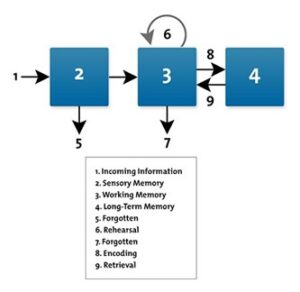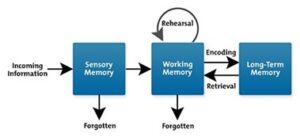Whether pitching for a project, or providing a quarterly review at a board meeting, we all want our presentations to be memorable. It is often considered a key determinant of success.
The problem is, our short term memory only holds 7 (+/- 2) items of information at any one time. So, the likelihood of the audience remembering everything that was said is relatively low. We must therefore give presentations in formats that work with our brains, so that more of it is remembered.
This is where the topic of cognitive load comes in. It is a theory that centers around the idea that our short term memory is limited, and explains how different types of information or environment can influence how much we can retain.
What is cognitive load?
In essence, if our brains have to work hard to process a piece of content, cognitive load is higher. This means it is less likely the information will be stored in our long-term memory. If the cognitive load is lower, it means the information is easier to process. So, there’s a better chance it will be remembered long-term.
There are two main types of cognitive load that we will discuss in this article: intrinsic and extraneous.
Intrinsic cognitive load
This refers to the brain’s difficulty processing complex information. If your audience are experts in your subject matter, they shouldn’t have too much trouble with the content. So, intrinsic cognitive load will be relatively low. However, if your audience do not know much about the subject, they may find the information hard to understand, process and remember, so intrinsic cognitive load will be high.
How to reduce it in presentations
Firstly, keep your audience in mind, and try to match your presentation complexity to their level of expertise. This ties in nicely with our first blog of the series, “Audience First”. If they are new to your subject, it helps to give context by providing some extra pre-learning. Remember to also write out any acronyms on the slide, to ensure everyone knows what they mean.
In addition, consider reducing the number of things you are talking about at any one time. Our brains automatically group related information together to improve recall, in a process called “chunking”. When the audience is made to comprehend several unrelated points at once, however, this doesn’t happen. So, it is important to focus on one point per slide. You may end up with more slides than you’re used to, but you’re still presenting the same content, in the same amount of time. It is just spread out in more digestible chunks to make your story clearer and help memorability too.
Extraneous cognitive load
The second type of cognitive load is extraneous. It is what distracts us, such as disruption from the environment, or a confusing presentation style. It is a large reason why people forget the information they are told.
How to reduce it in presentations
To reduce the amount of extraneous cognitive load, the first thing to do is create a calm and undistracting environment. Then, start your presentation with an agenda. Introducing your goals early will allow your audience to focus on the purpose of your slides, mentally piecing them together into your wider narrative.
When designing each slide, avoid lots of text, images or crazy animations that divert attention from your point. If we can only take in around 7 things at once, make sure they are all related to what you’re saying, rather than PowerPoint’s cool templates.
And finally, present related information together. Not just with text on a slide, but also within visual elements. For example, have a look at the diagram below, and imagine you had to learn the information. Confusing, right? Your brain must match up 1 with the description “incoming information” before it can start to figure out the meaning. This is a good example of extraneous cognitive load, distracting the viewer from what the information is telling them.
Whereas, when the diagram and labels are integrated, the unnecessary processing is reduced. It therefore allows you to focus wholly on what the content means:
So, to summarise, cognitive load is the amount of processing required of our brains. With complex information or a distracting environment, our cognitive load is greater, so the less we are likely to remember.
We hope you can use this information to make your presentations much more memorable. If you have questions, or want to know how we can help with your business presentations, email us at studio@maxwellrogers.co.uk.
References:
Fonollosa, J., Neftci, E., & Rabinovich, M. (2015). Learning of Chunking Sequences in Cognition and Behavior. PLOS Computational Biology, 11(11), e1004592. doi: 10.1371/journal.pcbi.1004592
Miller, G. (1956). The magical number seven, plus or minus two: some limits on our capacity for processing information. Psychological Review, 63(2), 81-97. doi: 10.1037/h0043158
Sweller, J. (1988). Cognitive Load During Problem Solving: Effects on Learning. Cognitive Science, 12(2), 257-285. doi: 10.1207/s15516709cog1202_4
The MindTools content team. (2019). Cognitive Load Theory: Making Learning More Effective. Retrieved 25 February 2021, from https://www.mindtools.com/pages/article/cognitive-load-theory.htm



